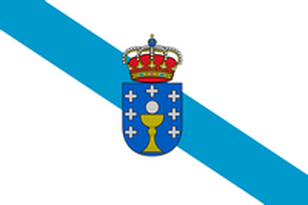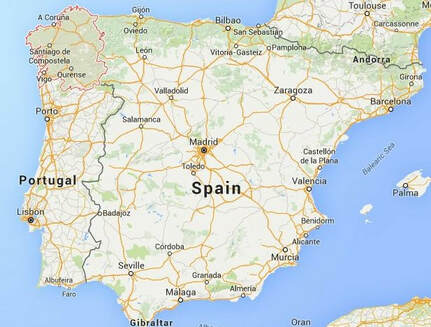Galicia

Galicia is an autonomous region of Spain. It is Located just north of Portugal in the northwest of the Iberian Peninsula. The region hosts the southern cape of the Bay of Biscay. The western cliffs of Cape Finisterre were considered by the Romans to be the end of the known world.
Galician and Portuguese used to be the same language. Contemporary linguists estimate that the two modern languages still share about 85% intelligibility. A century after Portugal’s independence (in the 13th century), the Galician-Portuguese language fragmented. It became Galician in the north and Portuguese in the rest of the territory. The official languages of Spain are: Catalan, Basque, Aranese, Spanish and Galician (Galego). Although a Celtic language has not been spoken in Galicia for centuries, the Galicia of antiquity was part of the Iberian peninsula where the Celtic language had its origins
Galician and Portuguese used to be the same language. Contemporary linguists estimate that the two modern languages still share about 85% intelligibility. A century after Portugal’s independence (in the 13th century), the Galician-Portuguese language fragmented. It became Galician in the north and Portuguese in the rest of the territory. The official languages of Spain are: Catalan, Basque, Aranese, Spanish and Galician (Galego). Although a Celtic language has not been spoken in Galicia for centuries, the Galicia of antiquity was part of the Iberian peninsula where the Celtic language had its origins

The 2016 population of Galicia numbered about 2.7 million people. That's just about equivalent to the population of Kansas. It's land area of roughly 11,500 square miles makes it slightly smaller than the land area of Maryland.
The traditional music of Galicia has characteristics similar to those found in the music of the other six Celtic Nations. Modern day Galicia is sometimes called the "Spanish Scotland". Bagpipes and snare drums are part of traditional Galician music. The region is not home to the flamenco music of southern Spain. The traditional heart of Galicia lies with the Celts more than it does with Mediterranean Spain.
The music of Galicia is both beautiful and unique. The standard repertoire of Galician traditional music includes polkas, waltzes, marches, rumbas and their version of the jig called muiñeira. The muineira is a fast tempo dance expressing gallantry but playful in character. Improvisation in the dance is common. Bag pipes often front the band and are supported by a kind of snare drum (tamboril) and bass drum (bombo). See the performance examples to view dancers performing the muiñeira.
The language of Galicia is Galego. No linguistic ties connect Galego with either goidelic or brythonic forms of Celtic language. To the modern ear, Galego sounds similar to Spanish or Portuguese. Galego is NOT a Celtic language.
The Galician bagpipe, gaita galega, is prominent in traditional music. Traditional performance often includes multiple pipes playing in harmony. Galitians also play an eight-hole oboe called the pitu and a six-hole transverse flute called the requinta. Snare drums called tamboril and bass drums called bombo are often part of a traditional Galican ensemble.
For more details about Galicia, its history and music download Xabier Blanco's PDF Galician Music - Lark Camp 2010.
You will find a blog about Galician music by Ernesto Campos, a contemporary artist at this link. Great background on tunes and composers. Hit the TRANSLATE button on your browser to read the text in English. Audio, video and lead sheets available on the site
http://www.blogoteca.com/ernestocampos/index.php?mes=8&ano=2018
Learn more about "The Galician Question" at this link.
Viva Galiza!!!
The traditional music of Galicia has characteristics similar to those found in the music of the other six Celtic Nations. Modern day Galicia is sometimes called the "Spanish Scotland". Bagpipes and snare drums are part of traditional Galician music. The region is not home to the flamenco music of southern Spain. The traditional heart of Galicia lies with the Celts more than it does with Mediterranean Spain.
The music of Galicia is both beautiful and unique. The standard repertoire of Galician traditional music includes polkas, waltzes, marches, rumbas and their version of the jig called muiñeira. The muineira is a fast tempo dance expressing gallantry but playful in character. Improvisation in the dance is common. Bag pipes often front the band and are supported by a kind of snare drum (tamboril) and bass drum (bombo). See the performance examples to view dancers performing the muiñeira.
The language of Galicia is Galego. No linguistic ties connect Galego with either goidelic or brythonic forms of Celtic language. To the modern ear, Galego sounds similar to Spanish or Portuguese. Galego is NOT a Celtic language.
The Galician bagpipe, gaita galega, is prominent in traditional music. Traditional performance often includes multiple pipes playing in harmony. Galitians also play an eight-hole oboe called the pitu and a six-hole transverse flute called the requinta. Snare drums called tamboril and bass drums called bombo are often part of a traditional Galican ensemble.
For more details about Galicia, its history and music download Xabier Blanco's PDF Galician Music - Lark Camp 2010.
You will find a blog about Galician music by Ernesto Campos, a contemporary artist at this link. Great background on tunes and composers. Hit the TRANSLATE button on your browser to read the text in English. Audio, video and lead sheets available on the site
http://www.blogoteca.com/ernestocampos/index.php?mes=8&ano=2018
Learn more about "The Galician Question" at this link.
Viva Galiza!!!
The Galician tunes below are presented in both standard notation and ABC notation. Click on the audio players to hear the tunes. If you want to download an mp3 files of a tune to study it in greater depth, go to the tune download page.
The performance examples show Galician ensembles and dancers. These groups are often fronted by bagpipes, use various drums and bombards in addition to familiar Celtic instruments. See the performance examples at this link
The performance examples show Galician ensembles and dancers. These groups are often fronted by bagpipes, use various drums and bombards in addition to familiar Celtic instruments. See the performance examples at this link
Tunes
Many of the Galician tunes posted here are dances in 6|8 time called "muiñeira". These are NOT jigs! A muiñeira may be danced in lines or circles or both. It is most often a couples dance. edited version of the Wikipedia entry for muiñeira is helpful:
The muiñeira is a traditional dance and musical genre of Galicia. It is distinguished mainly by its expressive and lively tempo, played usually in 6|8, although some variants are performed in other time signatures. There are also variant types of muiñeira which remain in the tempo of 6|8 but which displace the accent in different ways. Muiñeira is associated with traditional choreographic schemes and the associated instrumentation is a form of bagpipe known as a gaita. It is subject to highly varied interpretation in differing local traditions.
A HUGE collection of muiñeira is available at this link - miuneira
The muiñeira is a traditional dance and musical genre of Galicia. It is distinguished mainly by its expressive and lively tempo, played usually in 6|8, although some variants are performed in other time signatures. There are also variant types of muiñeira which remain in the tempo of 6|8 but which displace the accent in different ways. Muiñeira is associated with traditional choreographic schemes and the associated instrumentation is a form of bagpipe known as a gaita. It is subject to highly varied interpretation in differing local traditions.
A HUGE collection of muiñeira is available at this link - miuneira
Sets of Galician Tunes
| |||||||||||||
O Cabalo Azul is one tune. But this beautiful muineira will sound like a set. It has five parts. The transcription provided is in the key of E minor. But the original tune is usually set in D minor. The E minor setting seems to be friendlier to many traditional instruments. Concertina players advise that A minor is a good key for this tune. If you wish to change the key, load the ABC notation in Easy ABC and transpose it to whatever key you wish. This tune has more accidentals than most Celtic melodies. It's likely this one will be a challenge to play!
More Tunes from Galicia
|
| ||||||||||||
|
| ||||||||||||
|
|
| ||||||||||||||||||||||||||||||||||||||||||||||||||||||
More tunes from Galicia can be found at this website:
http://www.celticscores.com/origin/Galicia/
http://www.celticscores.com/origin/Galicia/